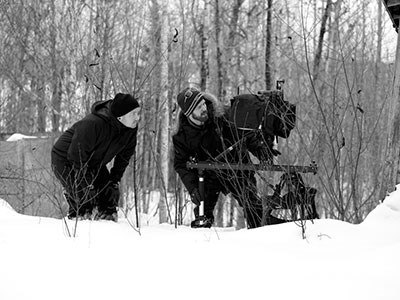Abudding Toronto filmmaker has paid an artistic and captivating tribute to his hometown of Red Lake with the release of his first feature-length documentary.
Cliff Caines’ 78-minute film, “A Rock and a Hard Place,” is a nostalgic and critical portrait of a resource-dependent town built upon some of the world’s richest gold deposits.
Under the umbrella of his production company, Headframe Films, the documentary received an honourable mention at the DOXA Documentary Film Festival in Vancouver this past May.
The catalyst for the project was in 2010 when he got wind of rumours that Goldcorp was evaluating the possibility of digging up entire subdivisions of Balmertown, a small community within Red Lake where he grew up, to convert the land into a huge open pit.
Drill rigs were turning in the streets and were planted on people’s front yards.
Documenting this end-of-days scenario was intriguing to Caines, but it was not yet a full-formed idea.
“I didn’t know if I had a film and I started going back up looking at the community with fresh eyes,” said the 35-year-old filmmaker after a recent screening in Red Lake.
The focus shifted when the interviews began.
Caines took up residence at his mother-in-law’s house and over a two-year period interviewed 50 to 70 people, ranging from old timers to migrant workers.
“These drills affected the community, but then all these other issues started to pour out of people,” on labour shortages, the lacking of housing and the frugal ways of the migrant workers.
“Red Lake has turned more into the camp model now than the town model. There’s certainly a tension between the culture and heritage of the community and a camp mentality.”
The fortunes of the 90-year-old community have always been tied to the price of gold, but his biggest takeaway is that Red Lake was ultimately built with an expiry date. It’s just a question of when.
“Red Lake is a really unique because they just keep finding gold deposits there, it keeps coming and coming.”
Both his parents worked at the Dickenson Mine until the family moved to Dryden in 1996 with Red Lake in the throes of a controversial four-year strike that still remains a taboo subject in town today.
His connections gave him access to people for some candid conversational interviews.
To help tell their stories, he filmed the mining sequence from start to finish; the cinematography capturing the rhythm, sound and the patterns of workers mucking the raw ore thousands of feet below ground to the final pouring of gold bricks at surface.
“I’m a proponent of slower films that allow you to dwell, and there’s a relationship between photographic and cinematic.”
As the machine rolls on, off-camera his interview subjects provide narration in examining the relationship between the company and community; from the mining camp’s early days to gripping life-and-death stories.
“When you see a giant dump truck pouring the ore and it’s juxtaposed against this highly charged, tragic story of someone dying under ore, it’s pretty literal,” said Caines. “At the same time this allows the viewer to walk away with their own relationship between the voice and the image.”
In blending cinematic art with industry, the documentary takes on a National Film Board time capsule-like quality to it.
“I consider myself an emerging filmmaker so I’m still developing my own language and style.”
His four-person production crew filmed at the Madsen Mine (now owned by Pure Gold Mining), Goldcorp’s Red Lake Gold Mines, and Rubicon Minerals’ Phoenix Gold Project.
The companies proved very accommodating in granting them underground access.
“To their credit I’m still shocked that there were open to us doing what we doing.”
Similar to filming men in combat, the ore face was referred to as the “front lines.”
The miners seemed to appreciate their work being documented and – to the detriment of their production bonuses – would step away for a few minutes to explain things or have their portraits taken.
While closely supervised for safety reasons, shooting underground was easily his most challenging production.
At the 3700 level of the Goldcorp Mine, where the rock is under pressure, they experienced one of the occupational hazards faced by miners.
“In one shoot we had one of the rocks burst like a bullet beside us, but for the most part they were all about safety when we were underground.”
His crew came away awestruck at the size of the operations.
“The scale of it was shocking for everyone. It just kept going and going. You get the sense of labyrinth in the film of tunnels upon tunnels.”
In May, the screenings he held for Red Lake high school students and the public was an eye-opener for many residents.
“The biggest response I got from the community was thank you for showing us what it’s like underground.” Shot for under $180,000, it took four years for Caines to cobble together funding from the Ontario Arts Council, by digging into his own pocket, and raising $25,000 through a crowdfunding campaign.
For future projects, Caines intends to further explore the relationship between labour and natural resources through the lens of cinema.
As a small independent film, Caines wants to screen it at film festivals in both the North and larger urban areas.
“I think it’s really important for someone working in a metropolitan area to see what happens in these remote areas.
“Even though the film is about Red Lake, it has universal appeal for mining communities, but also for industry towns.”




